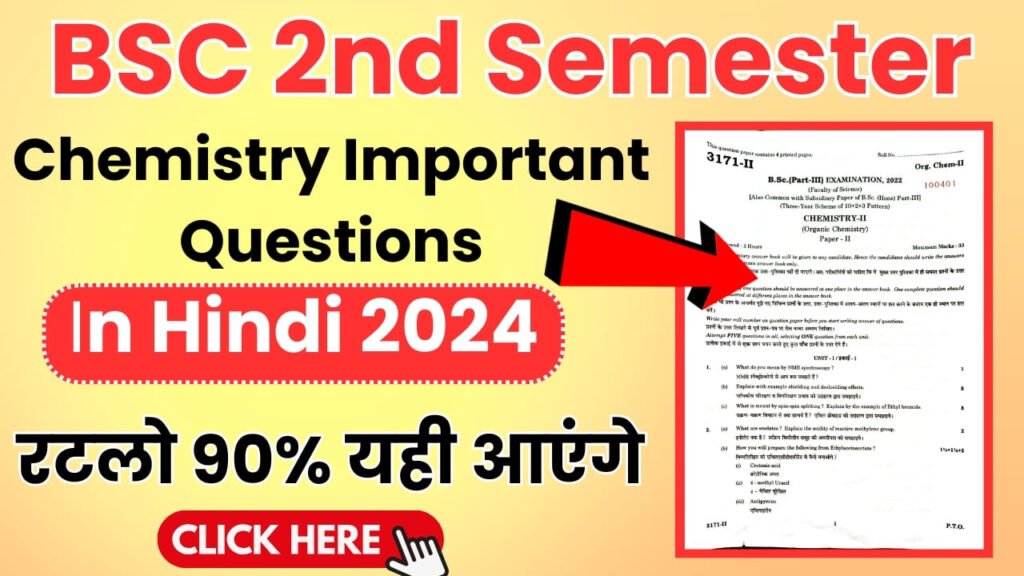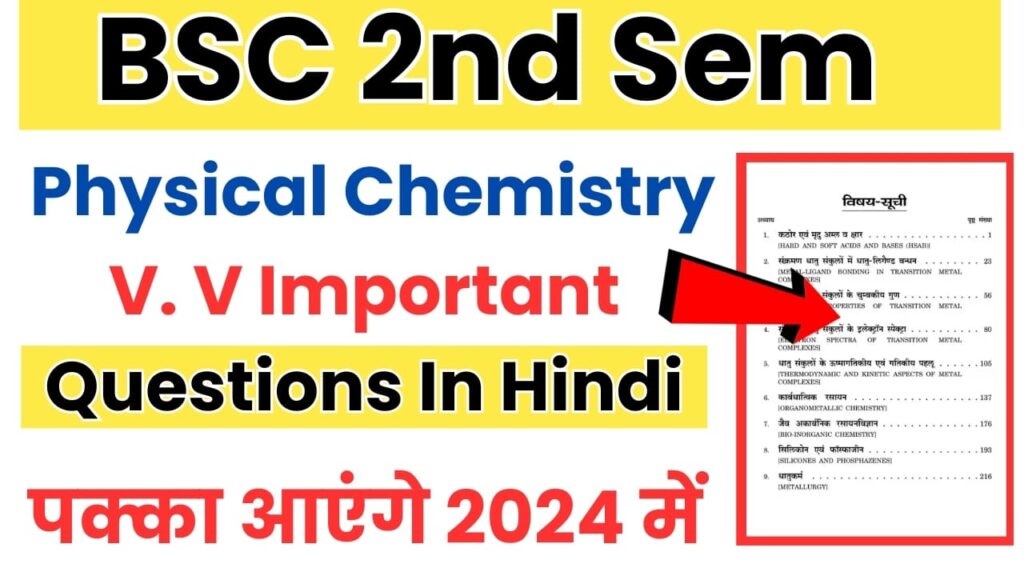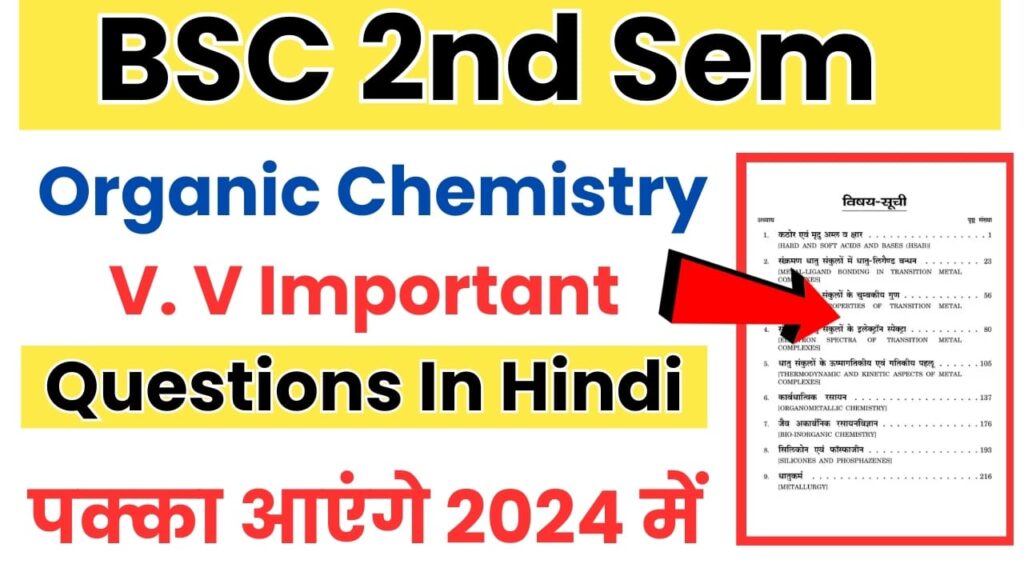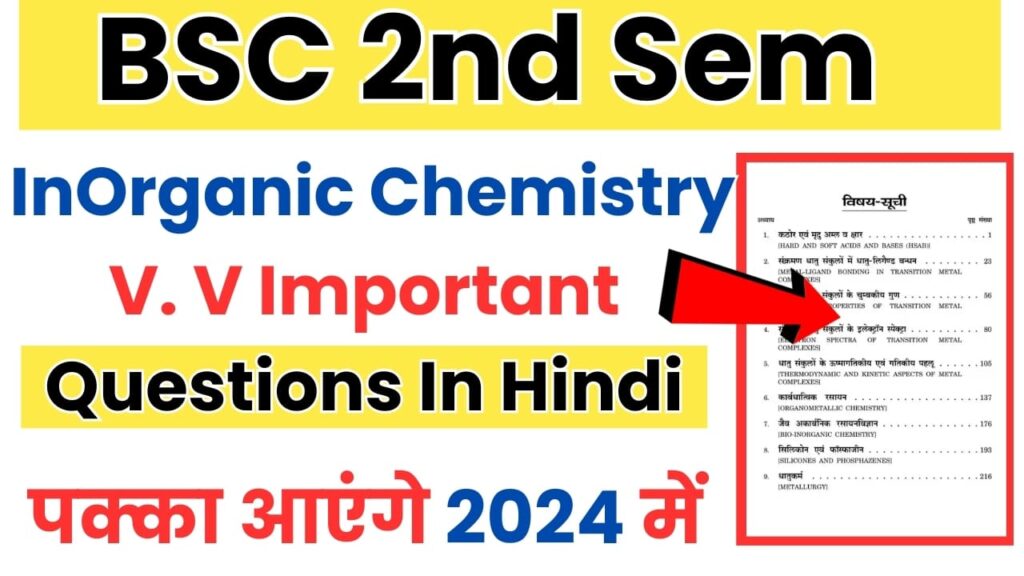नमस्कार साथियों क्या आप जानना चाहते है BSC 2nd Semester Chemistry Important Questions in Hindi 2024 के बारे में? दोस्तों आपका स्वागत है इस लेख में, हम आपको BSC 2nd Semester Chemistry Important Questions In Hindi के साथ BSC 2nd Semester inorganic chemistry important questions, BSC 2nd Semester organic chemistry important questions, BSC 2nd Semester physical chemistry important questions 2024 के बारे में सब कुछ बताएंगे।
जैसा कि आप जानते हैं Chemistry एक बहुत ही दिमाग लगाने वाला subject है, तो इस लेख में हमने BSC 2nd Semester Chemistry Important Questions इकट्ठा किया है जो कि आपको पढ़ने में मदत करेंगे अगर आप इस लेख में बताए हुए Important Questions को एक बार रट लेंगे तो आप समझ लो 60% syllabus cover हो जाएगा, तो BSC 2nd Semester Chemistry Important Questions In Hindi की पूरी सूची पढ़ने के लिए इस लेख को अंत तक जरूर पढ़ें ।

यह BSC 2nd Semester Chemistry Important Questions के महत्वपूर्ण प्रश्न 2024 प्रतिष्ठित संस्थानों के अनुभवी शिक्षकों द्वारा तैयार किए गए हैं, इन प्रश्नों के पेपर में आने की अधिक संभावना है, इसलिए इन्हें अच्छी तरह से तैयार करें।
Contents
BSC 2nd Semester Chemistry Important Questions in Hindi 2024

Q1: रसायन शास्त्र में अध्ययन क्या है? (What is the study in Chemistry?)
Answer: Chemistry is the study of matter and its properties.
Q2: सामान्य अणु का सिद्धांत क्या है? (What is the principle of the General Atom?)
Answer: The principle of the General Atom states that matter is composed of atoms.
Q3: इलेक्ट्रॉन की कमी क्या है? (What is electron deficiency?)
Answer: Electron deficiency refers to a situation where an atom lacks electrons.
Q4: समानांतर रिएक्टिविटी क्या है? (What is parallel reactivity?)
Answer: Parallel reactivity is when two or more reactions occur simultaneously.
Q5: धातुओं की रेखाएँ क्या हैं? (What are the lines of metals?)
Answer: Lines of metals are the metallic elements in the periodic table.
Q6: आवर्त सारणी के आविष्कारक कौन थे? (Who discovered the periodic table?)
Answer: The periodic table was discovered by Dmitri Mendeleev.
Q7: इसोटोप क्या होता है? (What is an isotope?)
Answer: An isotope is an element with the same number of protons but a different number of neutrons.
Q8: अधातु क्या है? (What is a non-metal?)
Answer: A non-metal is an element that lacks metallic properties.
Q9: उपश्रेणियाँ और उपप्रधान क्या हैं? (What are subcategories and sublevels?)
Answer: Subcategories are divisions within a category, and sublevels are energy levels within an atom.
Q10: परमाणु संरचना क्या है? (What is atomic structure?)
Answer: Atomic structure refers to the arrangement of protons, neutrons, and electrons in an atom.
Q11: धातुओं और अधातुओं की प्रमुख विशेषताएँ क्या हैं? (What are the main characteristics of metals and non-metals?)
Answer: Metals are good conductors of heat and electricity, while non-metals are poor conductors.
Q12: ऑक्सीकरण-अवक्षेपण प्रक्रिया क्या है? (What is the oxidation-reduction process?)
Answer: The oxidation-reduction process involves the transfer of electrons between reactants.
Q13: इलेक्ट्रॉन कोण का किरण है? (What is the charge of an electron?)
Answer: The electron has a negative charge.
Q14: यौगिक और अमौगिक द्रव्य में अंतर क्या है? (What is the difference between organic and inorganic substances?)
Answer: Organic substances contain carbon, while inorganic substances do not necessarily contain carbon.
Q15: आधार और शुक्तिक क्या हैं? (What are bases and acids?)
Answer: Bases are substances that can accept protons, while acids can donate protons.
Q16: इलेक्ट्रॉनिक संरचना क्या है? (What is electronic configuration?)
Answer: Electronic configuration is the distribution of electrons in an atom’s orbitals.
Q17: वाणिज्यिक आणविक क्रिया क्या है? (What is a commercial chemical reaction?)
Answer: Commercial chemical reactions are those used in industrial processes for large-scale production.
Q18: सूत्र और सूत्रग्रंथ क्या होते हैं? (What are formulas and formula books?)
Answer: Formulas represent the composition of a substance, while formula books list these formulas.
Q20: पारमाणविक संरचना के सिद्धांत कौन-कौन हैं? (What are the principles of atomic structure?)
Answer: Principles of atomic structure include the quantum theory and the uncertainty principle.
Q21: विभिन्न परमाणुओं के विभिन्न धराएँ क्या हैं? (What are the various properties of different elements?)
Answer: Different elements have unique properties such as atomic radius, electronegativity, and ionization energy.
Q22: अम्ल और उनके प्रकार क्या हैं? (What are acids and their types?)
Answer: Acids are substances that release hydrogen ions. Types include strong and weak acids.
Q23: परमाणु संयोजन क्या है? (What is atomic bonding?)
Answer: Atomic bonding is the attraction between atoms leading to the formation of molecules.
Q24: परमाणु संयोजन के प्रकार क्या हैं? (What are the types of atomic bonding?)
Answer: Types of atomic bonding include ionic, covalent, and metallic bonding.
Q25: ऑक्टेट का सिद्धांत क्या है? (What is the octet rule?)
Answer: The octet rule states that atoms tend to gain, lose, or share electrons to achieve a stable electron configuration.
Q26: सूक्ष्मीकरण क्या है? (What is ionization?)
Answer: Ionization is the process of forming ions by gaining or losing electrons.
Q27: सूक्ष्मीकरण के प्रकार क्या हैं? (What are the types of ionization?)
Answer: Types of ionization include electron ionization and chemical ionization.
Q28: धातुओं के अवस्थान क्या हैं? (What are the states of metals?)
Answer: Metals can exist in solid, liquid, or gaseous states depending on temperature and pressure.
Q29: सूची माध्यम से परमाणुओं के समरूपता क्या है? (What is isotropy of atoms through the periodic table?)
Answer: Isotropy refers to the similarity of atoms within a group in the periodic table.
Q30: समानांतर अवक्षेपण क्या है? (What is parallel displacement?)
Answer: Parallel displacement is the movement of reactants or products in a chemical reaction.
BSC 2nd Semester Physical Chemistry Important Questions in Hindi 2024

Q1: तापमान क्या है और इसकी मापनिक इकाइयाँ क्या हैं? (What is temperature and what are its measurement units?)
Q2: पैस्कल का सिद्धांत क्या है? (What is Pascal’s principle?)
Q3: गैस के आदिबंधन का लॉ और इसके सिद्धांत क्या हैं? (What is the law and principles of gas stoichiometry?)
Q4: विद्युत चुम्बकता का सिद्धांत क्या है? (What is the principle of electrical conductivity?)
Q5: गैसों के अंतर्मोल क्या हैं और इनके प्रकार क्या हैं? (What are intermolecular forces in gases and what are their types?)
Q6: विभिन्न ताप संचरण प्रक्रियाएँ और इनकी विवरण (Various heat transfer processes and their descriptions)
Q7: इसोथर्मल और इसोबारिक प्रक्रियाएँ (Isothermal and isobaric processes)
Q8: गैसों के रैद्ध्य में बदलाव और इसके कारण (Changes in gas density and their causes)
Q9: डाल्टन का सिद्धांत क्या है? (What is Dalton’s law?)
Q10: रसायन शास्त्र में अणुओं की संरचना (Atomic structure in chemistry)
Q11: विभिन्न तरल और तरल-वायवीय वायुमंडल द्रव्यों के गुणधर्म (Properties of various liquid and gaseous atmospheric substances)
Q12: गैसों के विशेष गुणधर्म और उनका मापन (Special properties of gases and their measurement)
Q13: अवस्थानिक रासायनिक संघटन और उनका प्रभाव (State chemical composition and its impact)
Q14: बर्नूली का सिद्धांत और इसके अनुप्रयोग (Bernoulli’s principle and its applications)
Q15: इलेक्ट्रॉन कंफ़िगरेशन और इसके तत्वों के परमाणु-संरचना (Electron configuration and atomic structure of elements)
Q16: परमाणुओं के सम्बंधित गुण (Related properties of atoms)
Q17: सारणी में अभिक्रिया तथा गैस के आदिबंधन का लॉ (Table of reactions and gas stoichiometry law)
Q18: थर्मोडायनामिक्स में प्रमुख सिद्धांत (Major principles in thermodynamics)
Q19: इनर्जी और उसके प्रकार (Energy and its types)
Q20: विशेष उष्मागतिकीय क्षमता (Specific heat capacity)
Q21: सबसे सरल रेनोल्ड्स की संख्या क्या है? (What is the simplest Reynolds number?)
Q22: संवेग और तेजगामी गति (Velocity and angular velocity)
Q23: सूक्ष्म वायवीय रेखाएँ और इनके प्रकार (Subtle molecular lines and their types)
Q24: सारणी के साथ संरचित की गई अवधारित आर्यभट्ट की गति (Aryabhata’s motion explained with a table)
Q25: पास्कल का सिद्धांत और इसके अनुप्रयोग (Pascal’s principle and its applications)
Q26 अधिकतम और न्यूनतम तापमान (Maximum and minimum temperatures)
Q27: अणुओं की इकाई (Units of atoms)
Q28: गैस की स्थिति और उसके अनुप्रयोग (Gas state and its applications)
Q29: तरल वायुमंडल में वायुमंडलीय चालक (Atmospheric conductors in the gaseous atmosphere)
Q30: विशेष तापीय ऊष्मागतिकीय विद्युत चुम्बकता (Special thermal electromagnetic conductivity)
BSC 2nd Semester Organic Chemistry Important Questions in Hindi 2024

Q1: ऑर्गेनिक रसायनशास्त्र में स्नायु क्या हैं? (What are the bonds in organic chemistry?)
Q2: कार्बन की खोज और उसके गुणधर्म (Discovery of carbon and its properties)
Q3: ऑर्गेनिक रेनोल्ड्स की संरचना (Structural isomerism in organic compounds)
Q4: नाइट्रोजन का संरचनात्मक स्थिति (Structural arrangement of nitrogen)
Q5: इलेक्ट्रॉन कंफ़िगरेशन और उसके प्रकार (Electron configuration and its types)
Q6: केतोन और ऐल्डिहाइडों में अंतरिक्ष अच्छाई (Space efficiency in ketones and aldehydes)
Q7: एल्केन्स में नामकरण और इसके नियम (Naming of alkenes and its rules)
Q8: विभिन्न ऑर्गेनिक यौगिक समीकरण (Various organic chemical reactions)
Q9: ऑर्गेनिक रसायनिक यौगिक समीकरण के प्रकार (Types of organic chemical reactions)
Q10: आलडीहाइड और केतोन का प्रतिपरिमाण (Aldehyde and ketone quantification)
Q11: स्नायु स्तर की रेखाएं (Bond levels in organic compounds)
Q12: नाइट्रोजन समीकरण (Nitrogen reactions)
Q13: विभिन्न एल्केनों की समीकरण (Reactions of various alkenes)
Q14: कार्बन की संरचना में बदलाव (Changes in the structure of carbon)
Q15: आलडीहाइडों की यौगिक रेखाएं (Chemical reactions of aldehydes)
Q16: इंडोल और इसकी संरचना (Indole and its structure)
Q17: ऑर्गेनिक रसायनिक यौगिक बनाने की प्रक्रिया (Process of making organic compounds)
Q18: स्नायु स्तरों की संरचना (Structure of bond levels)
Q19: नाइट्रोजन धातुओं की विशेषताएँ (Characteristics of nitrogen compounds)
Q20: एल्केनों में स्नायु समीकरण (Bonding reactions in alkenes)
Q21: ऑर्गेनिक रसायनिक यौगिकों का नामकरण (Naming of organic compounds)
Q22: केतोनों के समीकरण (Reactions of ketones)
Q23: इलेक्ट्रॉन कंफ़िगरेशन के सिद्धांत (Principles of electron configuration)
Q24: आलडीहाइडों के रैद्ध्य में बदलाव (Changes in the density of aldehydes)
Q25: स्नायु स्तरों में विभिन्नता (Diversity in bond levels)
Q26: समीकरण में इसोप्रोपाइल ग्रुप का प्रभाव (Effect of isopropyl group in reactions)
Q27: एल्केनों में स्नायु स्तरों की संरचना (Structure of bond levels in alkenes)
Q28: ऑर्गेनिक यौगिकों के परमाणु-संरचना में विभिन्नता (Diversity in atomic structure of organic compounds)
Q29: नाइट्रोजन और कार्बन रेनोल्ड्स की संरचना (Structure of nitrogen and carbon compounds)
Q30: स्नायु स्तरों के परमाणु-संरचना में बदलाव (Changes in atomic structure of bond levels)
BSC 2nd Semester InOrganic Chemistry Important Questions in Hindi 2024

Q1: धातु और अधातु का अंतर क्या है? (What is the difference between a metal and a non-metal?)
Q2: आधातुक बंधन और इसके प्रकार (Metallic bonding and its types)
Q3: समीकरण और असमीकरण धातुओं के उदाहरण (Examples of ferrous and non-ferrous metals)
Q4: आवर्त सारणी की संरचना और महत्व (Structure and significance of the periodic table)
Q5: हाइड्रॉजन और इसके उपयोग (Hydrogen and its uses)
Q6: सार्डाइड्स और सल्फाइड्स के बीच अंतर (Difference between oxides and sulfides)
Q7: धातु सूची में परिवर्तन और इसके कारण (Changes in the metal list and their causes)
Q8: धातुओं की ऊर्जा स्तरों का वर्णन (Description of energy levels in metals)
Q9: प्रमुख गैसीय आवृत्तियाँ (Major gaseous cycles)
Q10: सुपरकॉन्डक्टिविटी और इसके लाभ (Superconductivity and its benefits)
Q11: अल्काली धातुओं की खासीयतें (Characteristics of alkali metals)
Q12: अम्लों और उनके प्रकार (Acids and their types)
Q13: सैल्ट्स की प्रमुख गुणधर्में (Major properties of salts)
Q14: अल्कैलाइन धातुओं के विशेषताएँ (Special features of alkaline metals)
Q15: सूक्ष्म और सूक्ष्मतर धातुओं की सारणी (Table of micro and submicro metals)
Q16: आधातुओं के इसोटोप्स (Isotopes of metals)
Q17: सूक्ष्म धातुओं के उपयोग (Uses of micro metals)
Q18: धातु और अधातु में अवधारित बिंदु (Defined points in metals and non-metals)
Q19: रेडियोधर्मी और इसके प्रभाव (Radioactivity and its effects)
Q20: आवर्त सारणी में अभिक्रियाएँ (Reactions in the periodic table)
Q21: सुक्ष्म धातुओं के लक्षण (Characteristics of submicro metals)
Q22: धातु आण्विक रासायनिक संघटन (Metallic atomic composition)
Q23: अल्कैलाइन धातुओं के रासायनिक गुणधर्म (Chemical properties of alkaline metals)
Q24: अद्वितीय और इसके गुणधर्म (Indium and its properties)
Q25: परमाणु भार (Atomic weight)
Q26: धातुओं के विशेष भौतिक गुण (Special physical properties of metals)
Q27: सूक्ष्म धातुओं की संरचना (Structure of submicro metals)
Q28: अद्वितीय का परिचय और इसके उपयोग (Introduction to indium and its uses)
Q29: आवर्त सारणी में सम्बंधित समृद्धि (Related growth in the periodic table)
Q30: सूक्ष्मतर धातुओं के लाभ (Benefits of submicro metals)
हमें उम्मीद है कि इस लेख की मदद से आपको BSC 2nd Semester Chemistry Important Questions In Hindi 2024 के बारे में जानकारी मिल गई होगी।
दोस्तों आपको यह पोस्ट कैसी लगी कृपया हमें कमेंट सेक्शन में बताएं और यदि आपके कोई प्रश्न हों तो बेझिझक हमसे Comment Box में पूछ सकते हैं। यदि आपको यह पोस्ट उपयोगी लगी तो कृपया इसे दूसरों के साथ साझा करें।